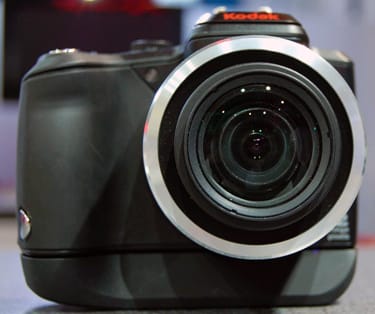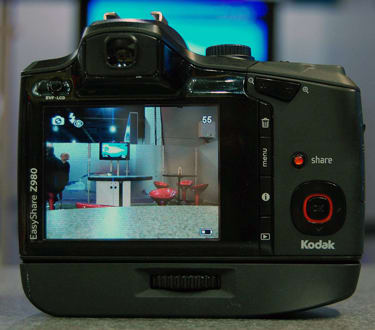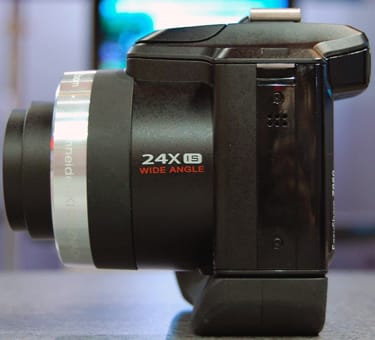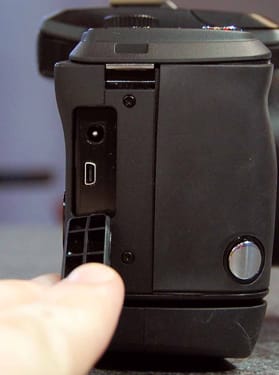Pros
Cons
Physical Tour

Front
The front of the Z980 is fairly nondescript. The huge 24x zoom obviously dominated this area, and there's a small auto focus assist lamp just to it's top left.

This lens means business
Back
In this photo of the back, you can see the additional grip in place, which substantially increases the bulk of the camera. The bottom grip is screwed on or off using the large dial seen here. For controls, there is a four-way pad with an OK button in the middle, which is used to navigate menus. If you flip the camera over into portrait mode, this pad controls the zooming. There's a large, bright Share button, which lets you tag images to be sent as soon as you hook your camera into a computer. Zoom controls are at the top right of the camera's back, and there's a series of four buttons along the edge of the LCD screen.

Here you can clearly see the extra size caused by the grip.
Sides*
*The left side has the speaker, the right has access to the USB and DC ports as well as the secondary shutter button. Lanyard loops are at the top of both sides.


The left and right sides of the camera
The top of the camera is jam-packed with controls and features. On the grip, there's a switch with a picture of a camera on it. Flicking this will set the camera into portrait mode, which disables the normal zoom and shutter controls, but lets you use the four-way pad for zooming and the shutter on the right side of the camera to take a photo. There are three buttons in a row, used for self-timer, macro and flash. The power button is not a standard two-position switch; rather it's sprung so it always resets to the same spot, and you just flick it on or off. Finally, there's a jog dial at the top left which is rotated to choose and alter settings in manual shooting modes.

The buttons are all placed near the grip
Here you can see the bottom of the camera both with and without the additional grip. You can see that when you install it, the grip blocks access to the battery and memory card hatch, and shifts the tripod mount considerably.


The bottom of the camera, without grip (top) and with grip (bottom).*
Components
**Viewfinder
**Most ultra-zoom cameras use an electronic viewfinder, and the Z980 is no exception. There's a small switch to the left of the viewfinder which switches the view between the LCD or the viewfinder (which has a resolution of 115,000 pixels).

The viewfinder, with controls directly to the left **LCD Screen
**The LCD measures three inches diagonally, with 230,000-pixel resolution, and can be set to five levels of brightness.

230,000 pixels and three inches are fairly common specs
**Flash
The Kodak Z980 has both a built-in flash and a hot-shoe, so you can use a optional external flash if needed. The built-in light can be set to auto, off, fill or red-eye reduction. The flash hot shoe offers some basic compatibility with any external flash, but will only be properly controlled if you purchase one from Kodak.

The built in flash
Lens
This being an ultra-zoom camera, the selling point of the Z980 is its massive zoom range. The lens reaches a massive 24x zoom (26-624mm equivalent), which is certainly one of the highest zoom ratios on the planet. The 26mm wide angle lens has an aperture range of f/2.8-f/8.0, which is slightly above average, and we'll be interested to see how it handles in our lab.

The fully extended lens
Connections
****The Z980 uses a standard micro-USB port for data transfer, and also has a DC-in port for an optional external power adapter.****

The camera's ports
Battery
The Z980 uses AA batteries, which on one hand provides the advantage of being incredibly easy to find and inexpensive, but on the other tend not to last as well as rechargeables.

The batteries and memory card.
Memory
The Z980 uses the low-priced and high-capacity SD and SDHC cards, which are more or less de facto for most digital cameras. **Other Features**
*Share button - *This feature wasn't fully working when we handled the camera, but it seems as though this function will be used to tag material for email or upload to the internet as soon as you plug your camera into your computer.
Design / Layout
Model Design / Appearance
The Z980 does as many ultra-zooms do, and borrows the look of an SLR camera, with a matte black body and large hand grip. The Z980 is a bit bigger than some other ultra-zooms, like the most of the Panasonic Lumixes, but is very light.
Size and Handling
The most distinctive feature of the Z980 is the second shutter control, which sits near the bottom of the camera's grip. If you flip a switch on top of the camera, then the normal zoom and shutter controls are disabled, and you can use the four-way pad to zoom and the second shutter button to take photos. The advantage to this switch in orientation is that it makes shooting photos in portrait orientation far easier. The camera also comes bundled with a second grip, which screws into the tripod mount, and makes it a bit easier to hold if you are using the alternate way of holding.
Some of the control schemes were also needlessly complex. For instance, to change any of the settings while in auto, aperture priority or shutter priority modesa, you have to use the jog dial to select the option, then press it down once, and rotate it more to change it. This feels unintuitive, and overly complicated.
*The Z980 has a distinctive second shutter button, which lets the camera to be easily
held in portrait (top) and landscape (bottom) orientations*
Menu
The menu system is clear, with large labels, and is easy to read. There's also the nice addition of two ways to alter any menu setting. When you use the four-way pad to navigate to an option, you can use the left and right buttons to scroll between the options, or press OK to see all your choices at once on a single screen.
**Ease of Use
**Kodak have helpfully included an Info button on the camera which will explain whatever setting you're looking to change, which is invaluable for new users.
Modes
Auto Mode
The Kodak's auto mode removes just about every available control from the user, but if you really want to take control, there's a pretty complete set of manual modes as well.
**Movie Mode
**The Kodak can shoot both 640x480 and 1280x720 at 30fps
**
Drive / Burst Mode**
On the subject of speeds, Kodak claims this camera takes less than 0.2 seconds to capture an image. We'll be sure to judge this claim once we get our hands on it, but if true, it would make the Z980 pretty quick off the block. At full resolution, you can take a maximum of nine images at one frame per second, or 3.5 frames per second at a reduced 3.1 megapixels. Kodak is also planning on having an even faster but lower resolution mode when the camera ships.
**Playback Mode
**The editing controls in playback are pretty minimal, as you can crop, fix red eye, tweak brightness and contrast, or string together up to three images in a panorama. There's also a tool called Perfect Touch, which is automatically on in Auto mode, but can also be applied to your photos taken in other shooting modes, which tweaks color levels and brightness slightly.
During playback, you can zoom in up to 8x, or out to 15 or 28 thumbnails. While in thumbnail view, you can sort the images by favorites, tags or date.
**Custom Image Presets
**The Z980 has a decent array of scene modes on offer: children, backlight, high ISO, beach, snow, sunset, self portrait, night portrait, candlelight, night landscape, landscape, manner/museum, stage, fireworks, flower and text.
Control Options
Manual Control Options
The Z980 has a significant degree of manual control, with a full set of Program, Aperture, Shutter and Manual modes. However, strangely absent is a custom white balance mode, which is usually fairly common, and one would expect to see on a camera that otherwise has a full set of manual controls.
Focus
Auto Focus
Auto focus can be set to multi-zone, center-zone and selectable zone, the last of which lets you choose the area of the frame where you would like to focus.
**
ISO
**The ISO runs from 64 to 1600, with 3200 and 6400 at reduced 3.1-megapixel resolution.
**
White Balance**
The range of manual white balance presets feels pretty limited, with only auto, daylight, tungsten, fluorescent and open shade on offer. As mentioned above, there is no way to manually white balance, a feature sadly lacking.
**Exposure Compensation
**Exposure compensation can be set ±2 EV in 1/3 steps, and the camera can auto exposure bracket at ±0.3, ±0.6 or ±1 EV.
Metering
Metering types available are multi-pattern (looks at whole image), center-weighted (looks at whole image but mostly center), center-spot (looks only at the dead center of the image).
**Shutter Speed
**Thanks to shutter priority and manual mode, the exposure length can be set directly to anything from 1/2000 to 16 seconds, a decent spread.
**
Aperture
Like shutter speed, aperture size can be manually set, and has a maximum level of f/2.8 wide and f/8.0 tele.
**
**Picture Quality / Size Options
**The Kodak Z980 has the ability to shoot RAW, or JPEG at three different compression qualities.
Picture Effects Mode
The only real picture effects on the Z980 are its color modes: high color, low color, natural color, sepia and black and white.
Conclusion
**
Conclusion**
The Z980 from Kodak is a camera we'll be very interested to get into our labs, but based on what we've seen on the floor at CES, we are very impressed with the 24x zoom, the full set of manual modes, and the ability to shoot in vertical orientation. However, it was not without flaws; we found the lack of manual white balance control an odd exclusion, and the build quality wasn't great (though that may be because it was a pre-production model).
Specs / Ratings
**Specs Table
**{{manufacturer_specs_table}}{{raw_scores_table}}
Meet the tester
Tim Barribeau is a valued contributor to the Reviewed.com family of sites.
Checking our work.
Our team is here to help you buy the best stuff and love what you own. Our writers, editors, and experts obsess over the products we cover to make sure you're confident and satisfied. Have a different opinion about something we recommend? Email us and we'll compare notes.
Shoot us an email